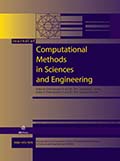Authors: Li, Qiang | Pan, Xiaoli | Fan, Wenyan | Zhou, Ying | Liu, Yongfu | Yu, Wangxin | Li, Dongyu | Li, Wenyue | Li, Weibin
Article Type:
Research Article
Abstract:
The study investigates the impact of different drying methods on the selection of thin-layer drying kinetic models, parameters, and quality for Exocarpium Citreic Grandis. This study investigates the drying characteristics, index constituents content, and microscopic structures of Exocarpium Citreic Grandis slices, subjected to three drying techniques: HAD (at 50, 60, 70 ∘ C), VD (at 50, 60, 70 ∘ C), and MVD (at 1000, 1500, 2000W). A thin-layer drying kinetic model was established. The findings demonstrated that the drying process was primarily dominated by the falling rate phase. When the drying temperature was 70
…∘ C and the microwave power was 2000W, the HAD VD, and MVD took 120, 360, and 20 minutes respectively. By fitting six commonly used thin-layer drying models, it was discovered that the optimal mathematical models for HAD, VD, and MVD were the Page model, the Logarithmic model, and the Page model, respectively. The highest average R 2 values were 0.9963, 0.9965, and 0.9964, and the lowest average RMSE values were 0.01782, 0.01704, and 0.0174 respectively. The effective diffusion coefficient increased with the drying temperature and microwave power, with MVD having the maximum coefficient. As the temperature and microwave power increased, the contents of naringin and rhoifolin decreased. However, the naringin content in MVD was 23.05% and 45.71% higher compared to hot air and VD respectively. The cross-section of Exocarpium Citreic Grandis dried via microwave vacuum exhibited a porous honeycomb structure with uniformly distributed spaces and larger pores, reflecting an expansion effect. The HAD process also resulted in a honeycomb-like structure, but with smaller pores. The VD process resulted in a layered structure with significant cell collapse. Microwave vacuum drying demonstrates superior energy efficiency and product quality compared to hot air and vacuum drying methods. The study finds that microwave drying does not have a destructive impact on the active compounds of Exocarpium Citreic Grandis. To facilitate large-scale, continuous production, microwave drying can be practically applied in industrial processing.
Show more
Keywords: Exocarpium Citreic Grandis, microwave vacuum, hot air drying, vacuum drying, thin-layer drying model
DOI: 10.3233/JCM-247143
Citation: Journal of Computational Methods in Sciences and Engineering,
vol. 24, no. 3, pp. 1363-1377, 2024
Price: EUR 27.50





